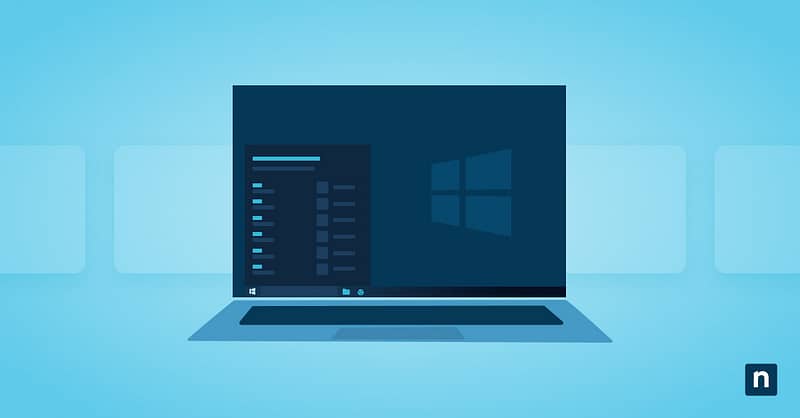Dictation is a native feature on Windows 10 that turns spoken words into text input using speech. Unlike older speech recognition systems, it can be used across browsers, apps, and text fields, optimized for speed, and relies on cloud services for higher security. Plus, it is available in multiple languages.
Using Windows Dictation enhances accessibility, boosts typing speed, and reduces physical strain. It is ideal in hands-free scenarios where keyboard use might be impractical, especially for users with injuries and touchscreen-only devices. Additionally, this feature can help improve workflows and aid users who need assistive controls.
So, how do you dictate instead of typing on Windows? This guide will explain how and provide essential considerations.
Windows Dictation requirements
Before using Windows Dictation, your system needs to meet several requirements.
- Your system needs to run Windows 10 version 1803 or later. Dictation is built into Windows 10 starting with the April 2018 update (1803).
- You need a working microphone to capture your voice. Laptops generally have one built in, but a high-quality external microphone is essential for a better experience.
- For Windows 10 Dictation to run smoothly, you need a fast and stable internet connection since it relies on Windows’ cloud-based speech service.
- The correct language packs containing the languages (e.g., English, Spanish, German) you want to dictate should be installed.
How to start using Windows Dictation to type
Once you have met the requirements above, you can start typing using Windows Dictation. Here’s how:
- The first step is to click on any field where you want to input text using your voice. It can be a blank document in apps like Notepad, Microsoft Word, or the search bar in your browser.
- Next, launch Dictation by using the Win + H shortcut. This will open the dictation toolbar, which appears near the top of your screen. When active, it listens for speech and converts it to text.
- Start speaking. Your words will be converted into text in real time, but be sure to do so clearly and at a natural pace.
- To stop the dictation session, you can say “stop dictation,” click the microphone icon, or press ESC on your keyboard.
Dictation Commands (English – U.S.)
When using Windows Dictation, you can speak specific commands to insert punctuation and formatting. Below are the most commonly used commands in US English:
| Action | Say |
| Insert period | Period |
| Insert comma | Comma |
| Start a new line | New line |
| Insert question mark | Question mark |
| Place an open parenthesis | Open parenthesis |
| Place a closed parentheses | Closed parenthesis |
| Insert an exclamation mark | Exclamation mark |
Note: These commands may vary depending on the language.
How to add supported languages in Windows Dictation
Windows Dictation supports multiple languages, enabling users worldwide to convert speech to text in their native tongue. However, accuracy may vary depending on the language. English (US) offers complete support and has advanced dictation commands.
Here are some of the supported languages:
- English (U.S., UK, Australia, Canada, India)
- French
- German
- Italian
- Spanish
- Chinese (Simplified)
- Portuguese (Brazil)
If you want to make a language available, here’s how:
- Open Settings.
- Navigate to Time & Language > Language.
- Click Add a Language, then select your desired language.
- Download the language pack, and if available, enable Speech Recognition.
Cloud vs. Offline dictation: Which is best for you?
You can operate Windows Dictation in two ways: cloud-based and offline.
- Cloud-based dictation is the fastest and most accurate. It uses Microsoft’s online speech services and requires an active internet connection.
- Offline dictation runs without an active internet connection if the appropriate speech pack has been installed. However, it may have reduced accuracy and not operate as well as cloud-based dictation.
You must check and manage your speech privacy settings to ensure they work as expected.
- Open Settings (Win + I).
- Navigate to Privacy and Security > Speech.
- Toggle Online Speech Recognition according to your preferences.
- Turn it ON to enable cloud-based dictation using Microsoft’s online speech services.
- Turn it OFF to force Windows Dictation to function offline.
Troubleshooting Windows 10 Dictation issues
When using Windows Dictation, you might run into a few stumbling blocks. Let’s look at some of them, along with the possible fixes.
Windows Dictation isn’t launching
If the feature isn’t launching, there are two possible ways to fix this:
- Ensure you’re running Windows 1803+ or later. If you’re not, you will have to update Windows.
- Verify microphone permissions. Go to Settings > Privacy & Security > Microphone and see whether microphone access is enabled for both the system and individual apps.
The dictation bar is not appearing
If the Windows Dictation bar is not appearing, press Win + H to relaunch the toolbar. If this doesn’t work, restart Windows Speech Services.
- Open Task Manager (Ctrl + Alt + Delete)
- Go to Processes and either find or type “Windows Speech Recognition” or “Speech Runtime Executable.”
- Right-click and select End Task.
- Relaunch it using the Win + H shortcut.
My microphone is not picking up my voice
If your microphone is not picking up your voice, follow these steps to ensure your computer is using the correct input device for dictation:
- Open Settings (Win + I).
- Go to System > Sound.
- Navigate to “Choose your input device” or “Choose a device for speaking or recording.”
- Select your chosen microphone. It can be a built-in device, or an external one like a desktop mic or a headset.
- You can test your microphone in the system settings to see if it functions using the Test your microphone feature in the same window.
The Windows Dictation language is incorrect
If the language is incorrect when typing dictation on Windows, ensure the input language matches the installed speech recognition language. You can verify and change via Settings > Time & Language > Language.
Windows Dictation use cases for admins & power users
Windows Dictation can be a powerful tool in various environments. It can enhance accessibility for specific users and improve productivity in managed and enterprise settings. Here are some use cases, along with practical applications:
Accessibility deployments for users with physical impairments
Voice dictation provides an alternative to keyboards for users with limited mobility and injuries. It can help reduce hand fatigue, especially for users whose work is centered around the keyboard, such as writers and communication specialists.
Kiosk or tablet environments where typing is impractical
In touch screen setups like kiosks, cashiers, field tablets, and fast-paced workstations, Windows Dictation allows fast and intuitive ways to enter data.
Hands-free note-taking in secure environments
This feature is essential in places where typing is impossible due to hygiene, safety, and protocol restrictions. These include places like clean rooms, labs, and manufacturing areas. For example, lab techs and industrial workers might need to update logs while their hands are occupied.
Integration with Microsoft 365 apps for accelerating workflows
Given that it is a Windows feature, Dictation works perfectly with Microsoft apps such as Word, Outlook, and OneNote. This lets employees draft emails, meeting notes, and essential documents in real time.
Use Windows Dictation to enhance accessibility and improve productivity
Windows Dictation is a valuable and easy-to-run tool that works with most applications. A quick and easy Windows + H shortcut gives users a hands-free way to work, making professional environments more inclusive by enhancing accessibility. Plus, it supports numerous languages and can improve productivity when integrated with workflows.








